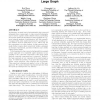Free Online Productivity Tools
i2Speak
i2Symbol
i2OCR
iTex2Img
iWeb2Print
iWeb2Shot
i2Type
iPdf2Split
iPdf2Merge
i2Bopomofo
i2Arabic
i2Style
i2Image
i2PDF
iLatex2Rtf
Sci2ools
EDBT
2012
ACM
2012
ACM
Finding maximal k-edge-connected subgraphs from a large graph
In this paper, we study how to find maximal k-edge-connected subgraphs from a large graph. k-edge-connected subgraphs can be used to capture closely related vertices, and finding such vertex clusters is interesting in many applications, e.g., social network analysis, bioinformatics, web link research. Compared with other explicit structures for modeling vertex clusters, such as quasi-clique, k-core, which only set the requirement on vertex degrees, k-edge-connected subgraph further requires high connectivity within a subgraph (a stronger requirement), and hence defines a more closely related vertex cluster. To find maximal k-edge-connected subgraphs from a graph, a basic approach is to repeatedly apply minimum cut algorithm to the connected components of the input graph until all connected components are k-connected. However, the basic approach is very expensive if the input graph is large. To tackle the problem, we propose three major techniques: vertex reduction, edge reduction ...
Database | EDBT 2012 | Edge Reduction | Input Graph | Vertex Degrees |
Related Content
| Added | 29 Sep 2012 |
| Updated | 29 Sep 2012 |
| Type | Journal |
| Year | 2012 |
| Where | EDBT |
| Authors | Rui Zhou, Chengfei Liu, Jeffrey Xu Yu, Weifa Liang, Baichen Chen, Jianxin Li |
Comments (0)

